Lapis lazuli
Lapis lazuli (/ˈlæpɪs ˈlæzjʊli, -laɪ/), or lapis for short, is a deep-blue metamorphic rock used as a semi-precious stone that has been prized since antiquity for its intense color.
| Lapis lazuli | |
|---|---|
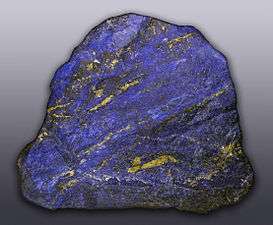 Lapis lazuli from Afghanistan in its natural state | |
| General | |
| Category | Metamorphic rock |
| Formula (repeating unit) | mixture of minerals with lazurite as the main constituent. |
| Crystal system | None, as lapis is a rock. Lazurite, the main constituent, frequently occurs as dodecahedra |
| Identification | |
| Color | Blue, or purple, mottled with white calcite and brassy pyrite |
| Crystal habit | Compact, massive |
| Fracture | Uneven-Conchoidal |
| Mohs scale hardness | 5–5.5 |
| Luster | dull |
| Streak | light blue |
| Specific gravity | 2.7–2.9 |
| Refractive index | 1.5 |
| Other characteristics | The variations in composition cause a wide variation in the above values. |
As early as the 7th millennium BC, lapis lazuli was mined in the Sar-i Sang mines,[1] in Shortugai, and in other mines in Badakhshan province in northeast Afghanistan.[2]
Lapis was highly valued by the Indus Valley Civilisation (3300–1900 BC), and lapis beads have been found at Neolithic burials in Mehrgarh, the Caucasus, and as far away as Mauritania.[3] It was used in the funeral mask of Tutankhamun (1341–1323 BC).[4]
By the end of the Middle Ages, lapis lazuli began to be exported to Europe, where it was ground into powder and made into ultramarine, the finest and most expensive of all blue pigments. It was used by some of the most important artists of the Renaissance and Baroque, including Masaccio, Perugino, Titian and Vermeer, and was often reserved for the clothing of the central figures of their paintings, especially the Virgin Mary. Ultramarine has also been found in dental tartar of medieval nuns and scribes.[5]
Major sources
Mines in northeast Afghanistan continue to be a major source of lapis lazuli. Important amounts are also produced from mines west of Lake Baikal in Russia, and in the Andes mountains in Chile. Smaller quantities are mined in Pakistan, Italy, Mongolia, the United States, and Canada.[6]
Etymology
Lapis is the Latin word for "stone" and lazulī is the genitive form of the Medieval Latin lazulum, which is taken from the Arabic لازورد lāzaward, itself from the Persian لاجورد lājevard, which is the name of the stone in Persian,[7] and also of a place where lapis lazuli was mined. Lazulum is etymologically related to the color blue and used as a root for the word for blue in several languages, including Spanish and Portuguese azul.[8][9]
Science and uses
Composition
The most important mineral component of lapis lazuli is lazurite[10] (25% to 40%), a feldspathoid silicate mineral with the formula (Na,Ca)8(AlSiO4)6(S,SO4,Cl)1-2.[11] Most lapis lazuli also contains calcite (white), sodalite (blue), and pyrite (metallic yellow). Some samples of lapis lazuli contain augite, diopside, enstatite, mica, hauynite, hornblende, nosean, and sulfur-rich löllingite geyerite.
Lapis lazuli usually occurs in crystalline marble as a result of contact metamorphism.
Color
The intense blue color is due to the presence of the trisulfur radical anion (S
3−) in the crystal.[12] An electronic excitation of one electron from the highest doubly filled molecular orbital (No. 24) into the lowest singly occupied orbital (No. 25)[13] results in a very intense absorption line at λmax ~617 nm.
Sources
Lapis lazuli is found in limestone in the Kokcha River valley of Badakhshan province in northeastern Afghanistan, where the Sar-e-Sang mine deposits have been worked for more than 6,000 years.[14] Afghanistan was the source of lapis for the ancient Egyptian and Mesopotamian civilizations, as well as the later Greeks and Romans. Ancient Egyptians obtained the material through trade with Aryans. During the height of the Indus Valley Civilisation, approximately 2000 BC, the Harappan colony, now known as Shortugai, was established near the lapis mines.[3]
According to the Sorbonne's mineralogist Pierre Bariand's leading work on the sources of lapis lazuli in modern times, and to references in Afghanistan's Blue Treasure: Lapis Lazuli (2011) by Lailee McNair Bakhtiar, the lapis lazuli is found in "caves" not traditionally considered "mines" and the stone lapis lazuli is from the primary source of the Hindu Kush Mountains in Afghanistan's Kochka River Valley and not in Pakistan.
In addition to the Afghan deposits, lapis is also extracted in the Andes (near Ovalle, Chile); and to the west of Lake Baikal in Siberia, Russia, at the Tultui Lazurite deposit. It is mined in smaller amounts in Angola, Argentina, Burma, Pakistan, Canada, Italy, India, and in the United States in California and Colorado.[6]
Uses and substitutes
Lapis takes an excellent polish and can be made into jewelry, carvings, boxes, mosaics, ornaments, small statues, and vases. During the Renaissance, lapis was ground and processed to make the pigment ultramarine for use in frescoes and oil painting. Its usage as a pigment in oil paint largely ended during the early 19th century, when a chemically identical synthetic variety became available.
Lapis lazuli is commercially synthesized or simulated by the Gilson process, which is used to make artificial ultramarine and hydrous zinc phosphates.[15] It may also be substituted by spinel or sodalite, or by dyed jasper or howlite.[16]
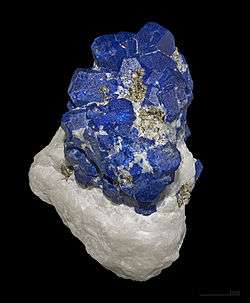 Crystals of lazurite (the main mineral in lapis lazuli) from the Sar-i Sang mine in Afghanistan, where lapis lazuli has been mined since the 7th Millennium BC
Crystals of lazurite (the main mineral in lapis lazuli) from the Sar-i Sang mine in Afghanistan, where lapis lazuli has been mined since the 7th Millennium BC A polished block of lapis lazuli
A polished block of lapis lazuli Natural ultramarine pigment made from ground lapis lazuli. During the Middle Ages and Renaissance it was the most expensive pigment available (gold being second) and was often reserved for depicting the robes of Angels or the Virgin Mary
Natural ultramarine pigment made from ground lapis lazuli. During the Middle Ages and Renaissance it was the most expensive pigment available (gold being second) and was often reserved for depicting the robes of Angels or the Virgin Mary 19th-century lapis lazuli and diamond pendant
19th-century lapis lazuli and diamond pendant
History and art
In the ancient world
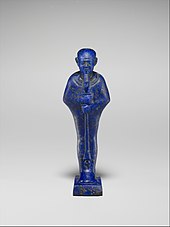
Lapis lazuli has been mined in Afghanistan and exported to the Mediterranean world and South Asia since the Neolithic age,[17] [18] along the ancient trade route between Afghanistan and the Indus Valley, dating to the 7th millennium BC. Quantities of these beads have also been found at 4th millennium BC settlements in Northern Mesopotamia, and at the Bronze Age site of Shahr-e Sukhteh in southeast Iran (3rd millennium BC). A dagger with a lapis handle, a bowl inlaid with lapis, amulets, beads, and inlays representing eyebrows and beards, were found in the Royal Tombs of the Sumerian city-state of Ur from the 3rd Millennium BC.[17]
Lapis was also used in ancient Mesopotamia by the Akkadians, Assyrians, and Babylonians for seals and jewelry. It is mentioned several times in the Mesopotamian poem, the Epic of Gilgamesh (17th–18th Century BC), one of the oldest known works of literature. The Statue of Ebih-Il, a 3rd millennium BC statue found in the ancient city-state of Mari in modern-day Syria, now in the Louvre, uses lapis lazuli inlays for the irises of the eyes.[19]
In ancient Egypt, lapis lazuli was a favorite stone for amulets and ornaments such as scarabs. Lapis jewelry has been found at excavations of the Predynastic Egyptian site Naqada (3300–3100 BC). At Karnak, the relief carvings of Thutmose III (1479-1429 BC) show fragments and barrel-shaped pieces of lapis lazuli being delivered to him as tribute. Powdered lapis was used as eyeshadow by Cleopatra.[3][20]
Jewelry made of lapis lazuli has also been found at Mycenae attesting to relations between the Myceneans and the developed civilizations of Egypt and the East.[21]
In late classical times and as late as the Middle Ages, lapis lazuli was often called sapphire (sapphirus in Latin, sappir in Hebrew),[22] though it had little to do with the stone today known as the blue corundum variety sapphire. In his book on stones, the Greek scientist Theophrastus described "the sapphirus, which is speckled with gold," a description which matches lapis lazuli.[23]
There are many references to sapphires in the Old Testament, but most scholars agree that, since sapphire was not known before the Roman Empire, they most likely are references to lapis lazuli. For instance, Exodus 24:10: "And they saw the God of Israel, and there was under his feet as it were a paved work of a sapphire stone..." (KJV). The term used in the Latin Vulgate Bible in this citation is "lapidus sapphiri", the term for lapis lazuli.[24] Modern translations of the Bible, such as the New Living Translation Second Edition,[25] refer to lapis lazuli in most instances instead of sapphire.
.jpg)
 Sumerian necklace beads; 2600–2500 BC; gold and lapis lazuli; length: 54 cm; Metropolitan Museum of Art (New York City)
Sumerian necklace beads; 2600–2500 BC; gold and lapis lazuli; length: 54 cm; Metropolitan Museum of Art (New York City) Sumerian necklace; 2600–2500 BC; gold and lapis lazuli; length: 22.5 cm; from the Royal Cemetery at Ur (Iraq); Metropolitan Museum of Art
Sumerian necklace; 2600–2500 BC; gold and lapis lazuli; length: 22.5 cm; from the Royal Cemetery at Ur (Iraq); Metropolitan Museum of Art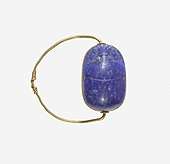 Ancient Egyptian scarab finger ring; 1850–1750 BC; lapis lazuli scarab set in gold plate and on a gold wire ring lapis-lazuli; diameter: 2.5 cm, the scarab: 1.8 cm; Metropolitan Museum of Art
Ancient Egyptian scarab finger ring; 1850–1750 BC; lapis lazuli scarab set in gold plate and on a gold wire ring lapis-lazuli; diameter: 2.5 cm, the scarab: 1.8 cm; Metropolitan Museum of Art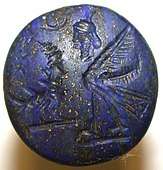 Neo-Babylonian conical seal; 7th–6th century BC; lapis lazuli; height: 2.7 cm, diameter: 2.1 cm; Metropolitan Museum of Art
Neo-Babylonian conical seal; 7th–6th century BC; lapis lazuli; height: 2.7 cm, diameter: 2.1 cm; Metropolitan Museum of Art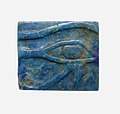 Ancient Egyptian plaque with an Eye of Horus; 664–332 BC; lapis lazuli; length: 1.8 cm, width: 1.6 cm; Metropolitan Museum of Art
Ancient Egyptian plaque with an Eye of Horus; 664–332 BC; lapis lazuli; length: 1.8 cm, width: 1.6 cm; Metropolitan Museum of Art.jpg) Greek or Roman ring stone; lapis lazuli; 2.1 x 1.6 x 0.3 cm; Metropolitan Museum of Art
Greek or Roman ring stone; lapis lazuli; 2.1 x 1.6 x 0.3 cm; Metropolitan Museum of Art Roman bead ornament; gold and lapis lazuli; 3 × 1.8 × 0.5 cm; Metropolitan Museum of Art
Roman bead ornament; gold and lapis lazuli; 3 × 1.8 × 0.5 cm; Metropolitan Museum of Art
See also
- Dvārakā–Kamboja route
- Lapis armenus – A variety of precious stone, resembling lapis lazuli, except that it is softer, and instead of veins of pyrite, is intermixed with green
- Lazurite – A tectosilicate mineral and a member of the sodalite group
- List of minerals – A list of minerals for which there are articles on Wikipedia
- Sar-i Sang
- Shades of blue – Variety of the color blue
References
Notes and citations
- David Bomford and Ashok Roy, A Closer Look- Colour (2009), National Gallery Company, London, (ISBN 978-1-85709-442-8)
- Moorey, Peter Roger (1999). Ancient Mesopotamian Materials and Industries: the Archaeological Evidence. Eisenbrauns. pp. 86–87. ISBN 978-1-57506-042-2.
- Bowersox & Chamberlin 1995
- Alessandro Bongioanni & Maria Croce
- Zhang, Sarah (January 9, 2019). "Why a Medieval Woman Had Lapis Lazuli Hidden in Her Teeth". The Atlantic. Retrieved May 9, 2020.
- "ICA - ICA". www.gemstone.org.
- Oxford English Dictionary
- Senning, Alexander (2007). "lapis lazuli (lazurite)". Elsevier's Dictionary of Chemoetymology. Amsterdam: Elsevier. p. 224. ISBN 978-0-444-52239-9.
- Weekley, Ernest (1967). "azure". An Etymological Dictionary of Modern English. New York: Dover Publications. p. 97.
- "Lapis lazuli: Mineral information, data and localities". www.mindat.org.
- "Lazurite: Mineral information, data and localities". www.mindat.org.
- Boros, E.; Earle, M. J.; Gilea, M. A.; Metlen, A.; Mudring, A.-V.; Rieger, F.; Robertson, A. J.; Seddon, K. R.; Tomaszowska, A. A.; Trusov, L.; Vyle, J. S. (2010). "On the dissolution of non-metallic solid elements (sulfur, selenium, tellurium and phosphorus) in ionic liquids". Chem. Comm. 46 (5): 716–718. doi:10.1039/b910469k. PMID 20087497.
- H. S. Rzepa, "Lapis lazuli: the Colour of Ultramarine." Accessed: 2011-03-06. (Archived by WebCite® at https://www.webcitation.org/5wyiNxh3B?url=http://www.ch.imperial.ac.uk/rzepa/blog/?p=3604)
- Oldershaw 2003
- Read, Peter (2005). Gemmology, Elsevier, p. 185. ISBN 0-7506-6449-5.
- Lapis lazuli, Gemstone Buzz.
- Moorey, Peter Roger (1999). Ancient mesopotamian materials and industries: the archaeological evidence. Eisenbrauns. pp. 86–87. ISBN 978-1-57506-042-2.
- Monthly, Jewellery (2015-04-02). "A complete guide to Gemstones". Jewellery & Watch Magazine | Jewellery news, jewellery fashion and trends, jewellery designer reviews, jewellery education, opinions | Wrist watch reviews. Retrieved 2017-08-28.
- Claire, Iselin. "Ebih-Il, the Superintendent of Mari". Musée du Louvre. Retrieved 10 October 2012.
- Moment of Science site, Indiana Public Media
- Alcestis Papademetriou, Mycenae, John S. Latsis Public Benefit Foundation, 2015, p. 32.
- Schumann, Walter (2006) [2002]. "Sapphire". Gemstones of the World. trans. Annette Englander & Daniel Shea (Newly revised & expanded 3rd ed.). New York: Sterling. p. 102.
In antiquity and as late as the Middle Ages, the name sapphire was understood to mean what is today described as lapis lazuli.
- Theophrastus, On Stones (De Lapidibus) – IV-23, translated by D.E. Eichholtz, Oxford University Press, 1965.
- Pearlie Braswell-Tripp (2013), Real Diamonds and Precious Stones of the Bible ISBN 978-1-4797-9644-1
- "In His Image Devotional Bible" ISBN 978-1-4143-3763-0
Bibliography
- Bakhtiar, Lailee McNair, Afghanistan's Blue Treasure Lapis Lazuli, Front Porch Publishing, 2011, ISBN 978-0615573700
- Bariand, Pierre, "Lapis Lazuli", Mineral Digest, Vol 4 Winter 1972.
- Bowersox, Gary W.; Chamberlin, Bonita E. (1995). "Gemstones of Afghanistan". Tucson, AZ: Geoscience Press. Cite journal requires
|journal=(help)CS1 maint: ref=harv (link). - Herrmann, Georgina, "Lapis Lazuli: The Early Phases of Its Trade", Oxford University Dissertation, 1966.
- Korzhinskij, D. S., "Gisements bimetasomatiques de philogophite et de lazurite de l'Archen du pribajkale", Traduction par Mr. Jean Sagarzky-B.R.G.M., 1944.
- Lapparent A. F., Bariand, P. et Blaise, J., "Une visite au gisement de lapis lazuli de Sar-e-Sang du Hindu Kouch, Afghanistan," C.R. Somm.S.G.P.p. 30, 1964.
- Oldershaw, Cally (2003). "Firefly Guide to Gems". Toronto: Firefly Books. Cite journal requires
|journal=(help). - Wise, Richard W., Secrets of the Gem Trade: The Connoisseur's Guide to Precious Gemstones, 2016 ISBN 9780972822329
- Wyart J. Bariand P, Filippi J., "Le Lapis Lazuli de Sar-e-SAng", Revue de Geographie Physique et de Geologie Dynamique (2) Vol. XIV Pasc. 4 pp. 443–448, Paris, 1972.
External links
| Wikimedia Commons has media related to Lapis lazuli. |
| Wikimedia Commons has media related to Medicinal minerals. |